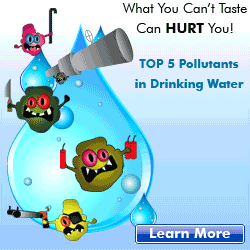
Not necessarily. Many chemicals that occur in nature can be harmful to your health, and they can dissolve in water. A few examples are arsenic, radium, radon, and selenium. Also, some nontoxic natural chemicals combine with other chemicals to produce harmful chemicals (reaction products). Therefore, some "natural" chemicals must be watched closely by your water supplier.
In spite of it all, it's important to note that humans have many natural defenses that buffer against normal exposures to toxins and these are mostly general, rather than tailored for each specific chemical. Thus they work against both natural and synthetic chemicals. Examples of general defenses include the continuous shedding of cells exposed to toxins. The surface layers of the mouth, esophagus, stomach, intestine, colon skin and lungs are discarded every few days; DNA repair enzymes, which repair DNA that was damaged from many different sources; and detoxification enzymes of the liver and other organs which generally target classes of chemicals rather than individual chemicals. It makes good evolutionary sense to conclude that human defenses are usually general, rather than specific for each chemical. The reason that predators of plants evolved general defenses is presumably to be prepared to counter a diverse and ever-changing array of plant toxins in an evolving world.
About 99.9 percent of the chemicals humans ingest are natural. The amounts of synthetic pesticide residues in plant food are insignificant compared to the amount of natural pesticides produced by plants themselves. Of all dietary pesticides that humans eat, 99.99 percent are natural: they are chemicals produced by plants to defend themselves against fungi, insects, and other animal predators. We have estimated that on average Americans ingest roughly 5,000 to 10,000 different natural pesticides and their breakdown products. Americans eat about 1,500 mg of natural pesticides per person per day, which is about 10,000 times more than the 0.09 mg they consume of synthetic pesticide residues.
Regulatory efforts to reduce low-level human exposures to synthetic chemicals proven to be rodent carcinogens are expensive; they aim to eliminate minuscule concentrations that now can be measured with improved techniques. These efforts are distractions from the major task of improving public health through increasing scientific understanding about how to prevent cancer (e.g., what aspects of diet are important), increasing public understanding of how lifestyle influences health, and improving our ability to help individuals alter their lifestyles.
Nonetheless, water suppliers must test for 90 chemicals regulated by the US Environmental Protection Agency under the Safe Drinking Water Act. This list is expected to grow in the future. Some of these are "natural", others enter water as pollutants due to human activity.



